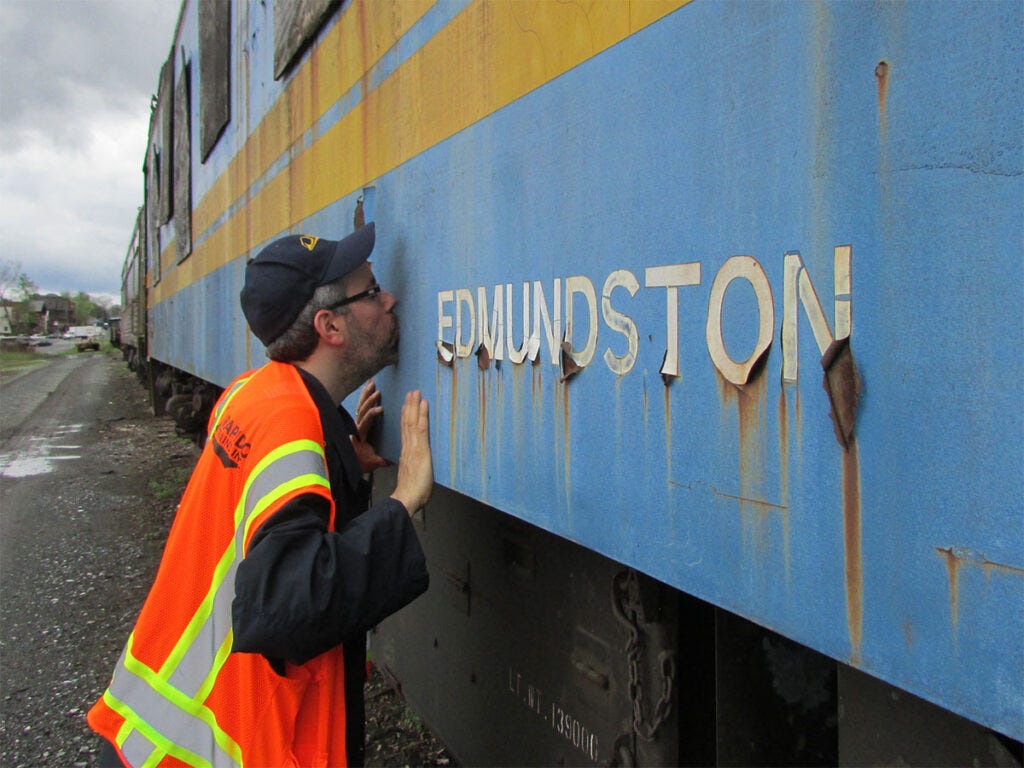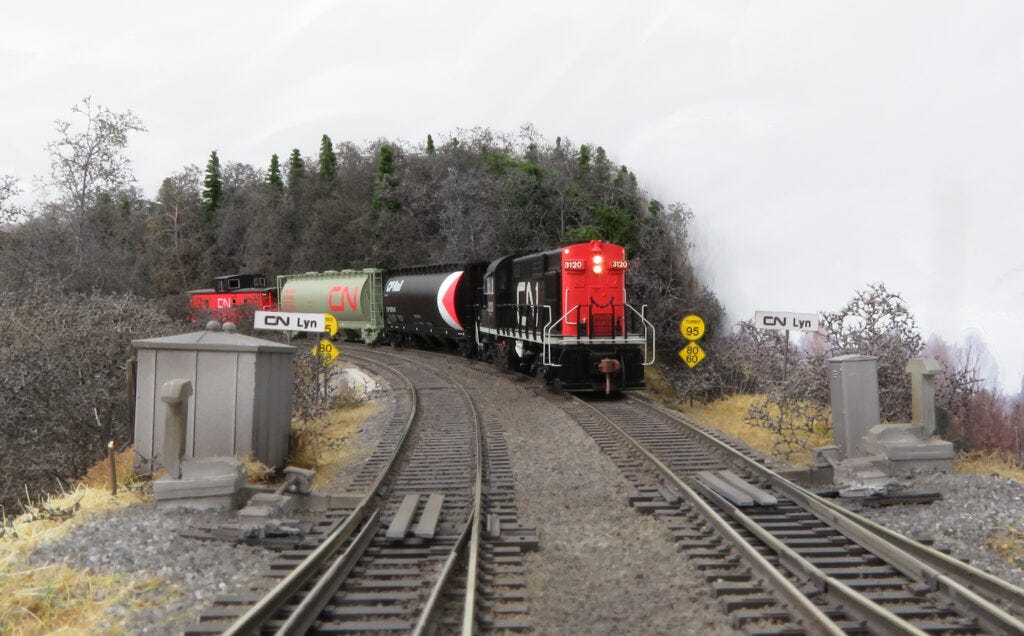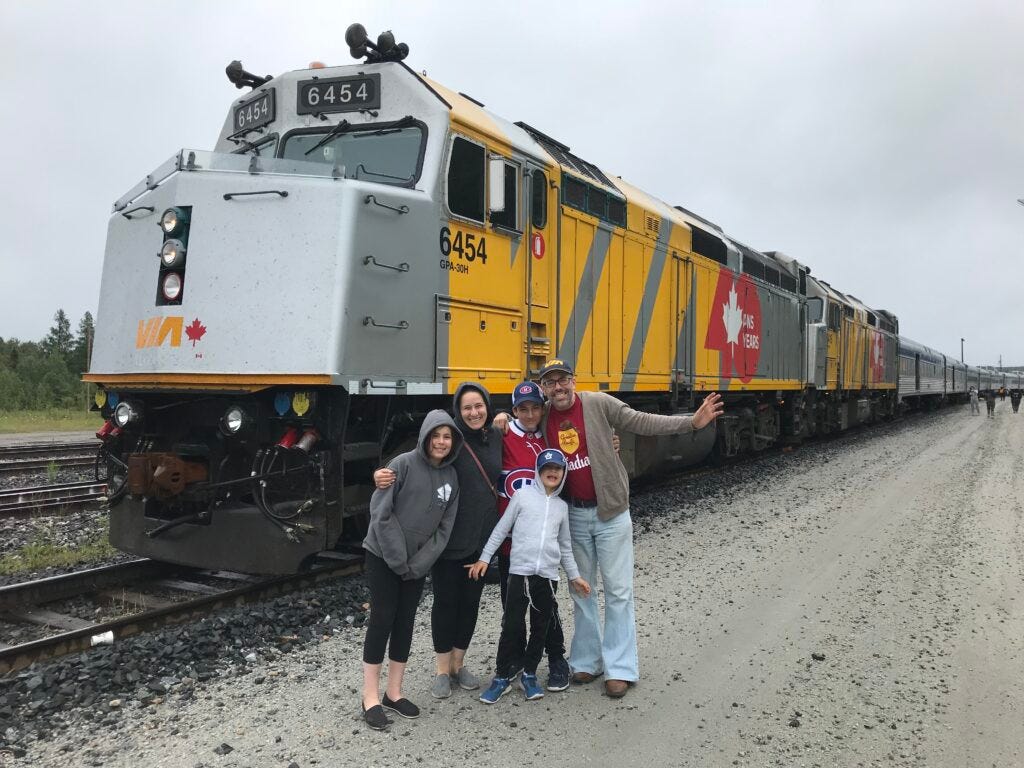“You have to have fun in this hobby. If you don’t have fun, what’s the point?”
Jason Shron embraces the former VIA Rail “Edmundston” sleeping car, now in preservation thanks to his efforts.
Like most hobbies, trains are a spectrum, where the involvement in the hobby can come in various degrees. On one end of the spectrum, there might be a casual train enthusiast who may take the scenic route on their drive home from work just to pass a set of railroad tracks in the hope of seeing the wayward train. On the other end of the spectrum, there might be a person who builds a full-scale replica of a passenger car in their basement. Today we will be speaking with a member of the latter option. Behind the Throttle is proud to feature Jason Shron, founder of Rapido Trains Inc, and self-proclaimed train nut.
Jason was born in 1975 in Montreal, Canada. At two years old, his family moved west to Toronto, which warranted several train trips to visit his remaining family still in Montreal. Jason’s earliest memories come from these frequent rides aboard early VIA Rail trains, especially aboard the famous TurboTrain – Jason’s first love. He distinctly recalls the return trip from his first visit back to Montreal, where he, his brother, and his father went to ride in the elevated section of the TurboTrain, where passengers could essentially peer over the engineer’s shoulder as the train sped across the countryside. From this moment on, Jason was truly infatuated with these experimental trainsets. With his limited vocabulary, he was constantly badgering his parents for the next ride aboard the “Fat Train,” as he called it. Something about the TurboTrain just called to him, and as he described it, “I didn’t choose [this passion], it chose me.”
Jason is seen here with RDC 6133 (left) and inside the Edmundston sleeping car (right), two of the preservation efforts that he and his company, Rapido Trains, kicked off. Also pictured on the left is Chris Fox, who oversees the restorations.
As trains became a more prominent fixture of the Shron household, Jason and his dad began building their first model railroad when he was four years old. On a piece of 4×8 plywood, Jason used his imagination to recreate scenes of the VIA Rail landscape that he had become smitten with. With Tyco products, Jason pretended that the flat wood, grass mat and plastic trains were the real deal, as he called out the station names along the Canadian National Kingston Subdivision that he quickly memorized. Growing up, Jason continued with his interest in VIA, and each train ride got more and more exciting as time went on (From our interview, I could tell that even at this stage in his life, Jason is still as interested in the Turbo as he was when he was a child, dropping random facts and statistics into conversation wherever possible). However, tragedy struck in 1982 when VIA opted to retire and scrap their remaining TurboTrains. “I remember my parents called me into their bedroom, told me the news…It was my first real experience with loss”, Jason described to me, as he recounted the sad day he learned that his favorite train had been put out to the pasture and all the existing examples would be scrapped. “At seven years old, I vowed to never let this happen again.”
As Jason grew into his teenage years, his interest with trains persisted and he became a more serious model railroader, even trying to scratchbuild a TurboTrain at 13 years old. When he was pursuing his Doctoral studies in Birmingham, England, in 2002, he spent more time kitbashing model VIA trains than actually working on his PhD. At this point, Jason began to think critically about what he wanted to do with his future. He soon realized that studying art history was in no way his true calling, but rather model trains were. Additionally, he was overall angered at the lackluster attempts at Canadian trains that were currently being produced by the mainstream manufacturers. After messaging with some fellow model railroaders on the primitive internet, he realized that “No one is going to bring out Canadian models if I don’t do it”. So, he did it. Jason dropped his degree, came home to Canada, and began working on building a new company, Rapido Trains. Jason’s father worked in the clothing industry, and so Jason opted to join him on a trip to China to find a model train factory that he wanted to work with. In Jason’s mind, Rapido was not going to be like any other manufacturer; Rapido would make trains so detailed that even details that could not be seen from any vantage point on the exterior of the model would be included. Once he found a factory capable of satisfying his borderline insane ideas, he got to work on his first project, a set of passenger cars with every possible bit of piping and conduit featured on the underside. To get these details as accurate as possible, he located a prototype in the wild and began taking measurements. In the dead of winter, Jason found himself under a train car in the middle of a field. He specifically recalled that he got his head stuck in between two pipes under the car, and found himself looking up a toilet chute. As he gazed up to where the bottoms of the travellers of yesteryear would perch and do their business, he realized this was his true calling.
In his almost non-existent free time, Jason diligently crafts on his depiction of the Canadian National Kingston Subdivison, as it appeared in the early winter of 1980. Though he understands that this layout may never be complete, he makes sure to enjoy every part of the journey.
Since Rapido’s founding, the company has grown exponentially, and has produced hundreds of models with an excruciating level of detail. In Jason’s mind, producing models with this much detail is necessary for railroad preservation. As with his beloved Turbo, many of the trains of history have been lost forever to the scrapper’s torch. As real estate and money in museums and historical sites is scarce, producing models with this much detail is the best way to preserve the legacy of these historic trains that have since been transformed into shaving products. In addition to manufacturing incredible model trains, Jason’s company has taken several initiatives in preserving real pieces of railroad equipment. When Jason learned that another piece of VIA’s history, the LRC (Light Rapid Comfortable) locomotive, was on the chopping block, he felt a sense of déjà vu to when the Turbo was scrapped. He worked tirelessly to save an example of the LRC locomotive, and has since done the same with a VIA Rail sleeping car and some of VIA’s Rail Diesel Cars (RDC). Along with some like-minded enthusiasts, Jason is in the process of launching The VIA Rail Historical Association, where several pieces of the passenger railroad’s history can be showcased to tell the story of where the railroad came from. “It’s the only way we can preserve history”, he stated with confidence and pride in how he has worked diligently to save equipment, and produce accurate models of prototypes that no longer exist.
Using parts from an actual VIA railcar, Jason constructed this amazing replica in his basement to double as his home office/personal haven. Complete with a speaker system that plays train sounds, actual seats from the real car, authentic carpeting, and even the small signage for the garbage cans, Jason officially wins the competition for “Coolest Zoom Background” with this train car.
Jason’s love for trains is illustrated by his commitment to his goals. At 12 years old, he made a plan to build a literal passenger car in his basement, which he has now accomplished. This incredible feat works as his home office, living room, and even play room for his children and him. The car took him nearly five years to build, with a wooden frame and parts from an actual retired passenger car that was destined for the scrap yard. In addition to converting his basement into a train station, Jason set out to write a formal book on his favorite passenger train. Having thought about the Turbo constantly since his first ride, the book took him about 15 minutes to write once he sat down and started typing. In addition to all of this, Jason is building a replica of a stretch of VIA’s Toronto-Montreal Mainline (The Canadian National Kingston Subdivision) in his basement (the part without a train car in it). This railroad is something he has also been planning since his childhood. Through all of these projects, Jason still makes sure to enjoy himself, and never take things too seriously. As seen with the humor that is prevalent in the instruction manuals and promotional videos from Rapido Trains, humor and fun are a cornerstone of Jason’s creations. “You have to have fun in this hobby. If you don’t have fun, what’s the point?” Jason remarked to me as he explained that he will always strive to find ways to enjoy the incredible path he has built for himself. Jason’s undeniable passion and his relentless work ethic are simply inspiring to someone who wants to make a difference in the world of railroading. Through thousands of hours of dedication, Jason has left a mark in the world of model railroad and preservation, and has much more to come. Above all, Jason Shron is a guy who likes trains, and through his devotions, he has left a permanent mark on the world.
Jason and his family in front of a modern day VIA passenger train.
Check out some highlights from our interview with Jason in this video!
Thank you for reading this edition of Behind the Throttle. Tune in next time for another narrative of a distinguished railroader. Until then, I’ll I’m Max Harris, and I’ll see you all down the line.
2025 Update: Jason’s life in 2025 is still full of trains, big and small. His company, Rapido Trains, has only grown and even expanded to international markets with a UK-based company making models of European trains to an immense standard of detail. The VIA Rail Historical Society has also grown with an impressive fleet based in Toronto.









